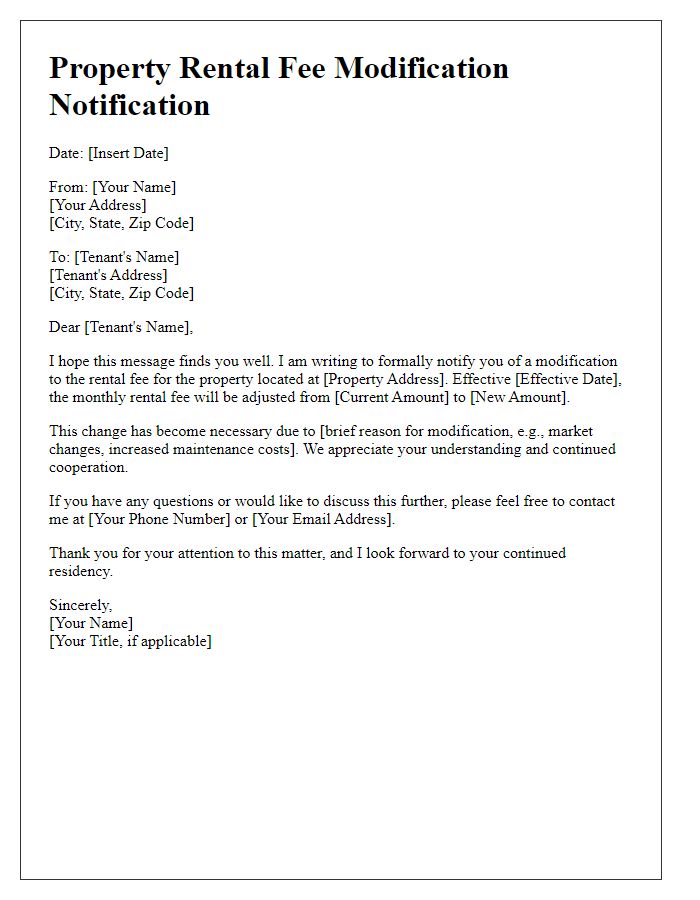Are you a landlord looking to notify your tenants about a rental increase, but unsure how to communicate this sensitive information? Crafting a clear and respectful notice is key to maintaining a good relationship while keeping your property profitable. In this article, we'll explore the essential elements of a rental increase letter, providing you with a template to ease the process. Ready to learn how to navigate this conversation smoothly? Let's dive in!

Clear Communication
A rental increase notice should clearly outline the new rental amount, effective date, and any relevant justifications for the increase, such as property maintenance costs or market trends. For instance, a landlord may notify tenants that from December 1, 2023, the rent will increase from $1,200 to $1,350 monthly due to increased local property taxes in San Francisco, California. This increase aligns with the regional rental market trends, which have reported a 15% rise over the past year, according to the latest rental market analysis by Zillow. Clear documentation should accompany the notice, ensuring tenants understand their rights and any provisions for negotiating or contesting the new rental terms. Timeliness in delivering this notice is essential, often requiring at least 30 days' notice to comply with local housing regulations, fostering transparency and trust between landlords and tenants.
Legal Compliance
In jurisdictions such as California, landlords must adhere to specific regulations regarding rental increases. For example, in Los Angeles, California laws permit rent increases of no more than 5 percent plus the local rate of inflation (CPI) annually, or 10 percent, whichever is lower, for most residential units under the Rent Stabilization Ordinance. Tenants typically require written notice at least 30 days in advance for increases less than 10 percent, or 90 days for increases exceeding that threshold. This written notice must clearly state the new rental amount, the date when the increase takes effect, and reference relevant laws such as the California Civil Code Section 827. Ensuring compliance with these statutes is crucial to avoid potential legal disputes and to maintain a positive landlord-tenant relationship.
Effective Date
Notice of rental increase informs tenants about an upcoming adjustment to their monthly rent amount. The effective date for the increase can typically vary depending on local housing regulations. For example, if the rent increase is announced in a jurisdiction like California, landlords must often provide a notice at least 30 days before the change takes effect if the increase is under 10%. Specific details regarding the new rent amount, reasons for the increase, and any state or city-specific rules governing rent adjustments should also be clearly outlined to ensure transparency and compliance with legal requirements.
Justification for Increase
Rental increases in urban areas often arise from various economic factors, such as rising maintenance costs, property management expenses, and inflation rates. For instance, median rent prices in cities like San Francisco have surged by over 30% in the past three years, reflecting demand outpacing supply. Additionally, utilities and services such as water, heating, and garbage collection have seen increases of 15% annually in many regions. The Consumer Price Index (CPI) rose by approximately 6.2% in the past year, emphasizing the need for adjustments to rental agreements. Such increases are not only aligned with market trends but also essential to ensure the ongoing maintenance and safety of rental properties, protecting tenant interests in the long term.
Contact Information
Rental increase notices serve as formal communications from landlords to tenants regarding changes in rental payments. In a typical notice, the landlord must include specific contact information, such as the landlord's full name, mailing address (including city and zip code), and phone number for direct communication. Additionally, an email address may be provided for convenience and swift responses. The notice should also feature the tenant's name and current address to ensure clarity in communication. Under local laws, details about the new rental amount, effective date, and any relevant ordinances or regulations governing the increase should be highlighted. This structured approach maintains transparency and helps prevent disputes.













Comments